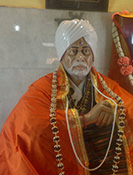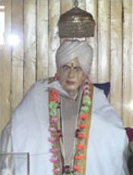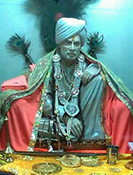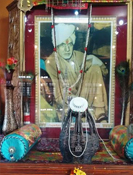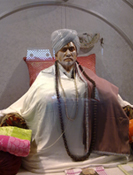The Great Bhagavaan Ji & the Panchastavi
As told by P N Koul Ji, Bab Bhagavaan would at times read some of the Shlokas of the Panchastavi.
Panchastavi Pattham would charge the whole atmosphere of the Ashram, at Nai Sarak Guddod Bagh with Divine radiance. The power of the Shakti, which creates the worlds, say Trikaaran Rupa, with the primal Agamic sound which is AIM. It is the conceptive self-extinction of Being, which works itself, out in the Brahmanda, which is universe, as substance. It is Chaitanyam--the object of consciousness, which represent the Adyaa Shakti Bhavani. The Panchastavi is the synthesis of the Divine attributes of the Tripura Devi, revered as the Tripura sundari, who is none elsebut Raginya Devi,according to the saints and sages, Bab ji would also say so. The Forth Chapter is revered as the Laghustavah. The word Laghu means light, not heavy. It means that the Dharana on the Divine attributes should be contemplated upon her Light ones, as the Sadhaka in the initial stage can not resist the intensity of the luster of Shri Raja Rajeshvari. Our first decisive step out of our human intelligence , is an ascent to the higher ones, starting from pure Bhakti, like that of a newborn baby, who conveys not through his/her word but the cry, which is Adi Spanda, the very breath of his/her soul. The aspirant calls her Jyotirmayi, Vaangmayi. She is the Mother of effulgence, as She is Ambaa--the affectionate Mother of the Devotee The word carries the great weightage, as She is the protector of the universe, and so of the devotee, in particular
Aim Klim Sauh are the Bija Mantras of the Tripura Devi. Though She is Ambaa, but she assumes the form of Chandi to destry the Asuri--demonic forces. A Bhakta is the Central being in the Panchastavi, who sees the Tripura around him/her. A concentrated mind for Sadhana is the quintessence of the Panchastavi Pattham.
Her Divine message is in the Sakala form of the universe, where she holds the hand of the devotees, to make them evolved in the higher consciousness of Sadhana.
The Second canto is dedicated to Charcha--the spiritual deliberation of the Divine Mother. Charcha is based on the Buddhi Tattva though it is more intellectual in nature, yet it develops the devotion, where the Shlokas are described in the philosophical manner. This happens to be the stream of the cosmic moment. Beyond the elementary understanding of the Divine Mother as Amba, a devotee wants to go in for Ananda, as the first Shloka implies. It is Truth beauty and goodness Where the Bija Mantra 'Klim' gives rise to Primary, ultimate and eternal life. It is the foundation of oneness in ecstasy.
The Third Chapter Ghatastava---,which gives the Bhakta to experience the Divine attributes as Devi, Trayambaka Patni, Parvati, Sati, Trailokyamata, Shive, Sharvaani, Tripura, Mridaani, Varade, Rudrani, Katyayani, Bhime, Bhairavi, Chandi, Sharvari, Kale, Kaalakshye, Shuulini. This is the great pitcher of profound sublimity, whwere the intuitive mind sees the Divine in complete surrender of the Tripura--the consort of Shiva. The content and the concept merge together; reason and mind / antahkaran go together in search of that great pitcher, which is but the Divine grace. Transformation takes place, and the devotee sees the Divine realms around him, or her.
The Fourth canto is dedicated to the Ambastava--a laudation to the Divine Mother. The Ishta devi is adored with all the devotion, keeping the norms of the Kulachara in tact She is seen with all the Divine weapons,. She is Girija, the Parvati, who is pure Sattva like the pure gold, where there is no Rajas and no Sattva. In this Puja ,the Devi blesses with Chita shudhi. This is the period of self-analysis of complete surrender to the DIvine Mother.
The last Canto is Sakala Janani satva--the Mother of all existence. Bab Ji would emphasize to study the Panchastavi whole heartedly it and to arrive at the feet of the Mother sharika
Chamanlal Raina






